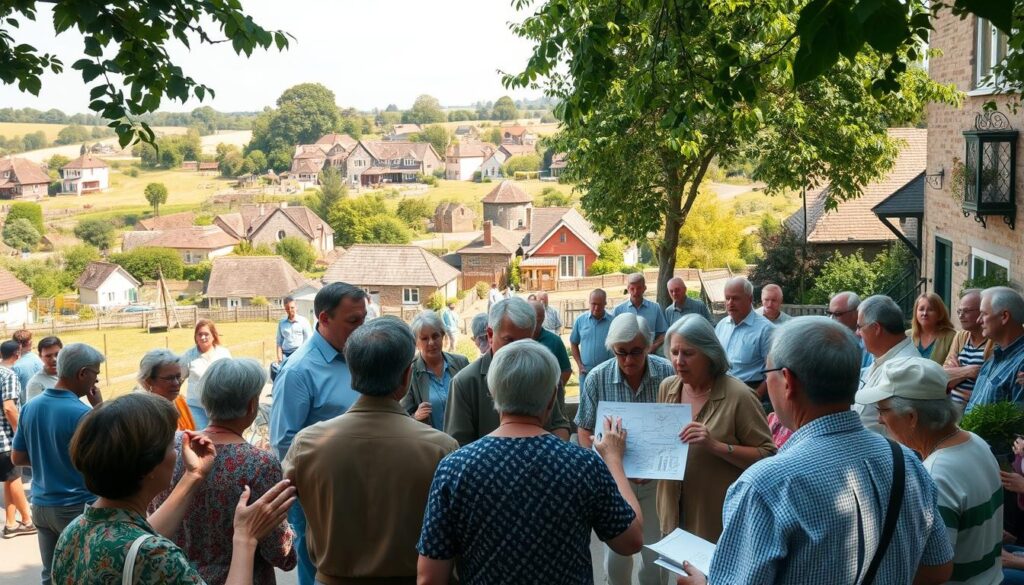Managing sound in the countryside is key to a good quality of life and protecting nature. In rural areas, noise comes from farming, wildlife, and sometimes, industrial work. Unlike cities filled with cars and construction noise. It’s important to handle these sounds well. This keeps the peace, looks after people’s health, and saves the ecosystem.
What Is Rural Noise and Why Is It Important?
Rural noise comes from farming, wildlife, and fun activities outside the city. It includes tractor noises, animal sounds, and birds chirping early. These sounds make the countryside special but can also bring challenges. This shows why managing sound is key.
Managing these sounds is vital for keeping balance in nature’s soundtrack. It helps people living in the countryside feel more at ease. Less noise means fewer disturbances for them.
It’s also important for wildlife. Too much noise can upset their lives and homes. By taking care of sound, we help animals and people live better together in the countryside.
Common Sources of Noise in Rural Areas
Noise in rural areas often comes from agricultural noise sources. One big source is farm machinery noise. This includes sounds from tractors, harvesters, and other big equipment used in farming. These machines help with farm work but can be very loud, especially when it’s busy.
Animal sounds from livestock are another major source of noise. Cows mooing, chickens clucking, and pigs grunting are common. These sounds may seem normal. But in large numbers, they make a lot of noise too.
Keeping the land in good condition also causes noise. This comes from mowers, chain saws, and irrigation systems. These tools are important for looking after the land. Yet, they add to the noise in the countryside.
Transportation adds to rural noise too. Even though there’s less traffic than in cities, trucks and other vehicles on rural roads make noise. It’s important to know about these agricultural noise sources. This helps us find ways to reduce their noise, making life more peaceful for rural communities.
The Effects of Rural Noise on Health
Rural places may seem quiet, but they’re not free from noise pollution. Noise from farming gear, vehicles, and nature can hurt the health of people living there. These sounds interfere with the peace of rural settings.
Noise in the countryside can harm your hearing just like in cities. It can mess up your sleep, which affects your overall health. People living with this noise may feel more stressed and have health problems.
Rural noise pollution is different from city noise. It’s less constant and more random. This can cause different mental effects. We need special plans to lower these health risks.

Working on noise issues can make rural health better. By learning how noise impacts health, we can create ways to fight it. As research grows, we hope rural areas can stay peaceful and healthy.
Measuring Rural Noise Levels
Measuring rural noise properly is key to keeping the countryside peaceful. To check noise in these areas, experts use special methods and gear. This lets them fully grasp and manage the sounds in rural spots.
They mainly rely on tools like sound level meters and noise monitors. These devices capture how loud and long different noises are. By studying this data, experts can understand the area’s sound environment well.
To show how these methods work, here’s a table with noise levels from various rural spots:
| Location | Average Sound Level (dB) | Peak Sound Level (dB) | Typical Noise Sources |
|---|---|---|---|
| Farmstead | 55 | 75 | Machinery, Animals |
| Forest Edge | 40 | 60 | Wildlife, Wind |
| Riverside | 45 | 65 | Water Flow, Birds |
| Rural Road | 65 | 85 | Vehicles, Human Activity |
Knowing what the noise monitors pick up helps in handling rural noise. It matters when planning buildings, reducing noise from structures, or keeping natural sounds. With careful noise study and actions, we can protect the calm of rural places.
Managing Rural Noise: Effective Strategies
Managing rural noise well needs many steps. This includes new technology, better farming methods, community projects, and rules. Each part is key to lessen noise in the countryside.
Noise barriers are very helpful. This could be trees or walls that lower noise by blocking or absorbing sound. They keep homes and areas quiet.
New tech helps a lot too. For example, quieter engines on farm machines. These changes make farming less noisy and more efficient.
Community-led efforts are also important. They involve meetings and teaching about noise control. This helps everyone work together to lower noise.
Rules and laws play a big role as well. Local governments can set noise limits and fine those who are too loud. This helps keep the countryside peaceful.
Here’s a short list of these methods:
- Use of natural and man-made barriers to block noise.
- Quieter farm machinery and tech.
- Community efforts to spread knowledge on reducing noise.
- Laws to keep noise down.
Community Involvement in Noise Management
Managing noise in rural areas greatly benefits from community involvement. When folks join in on conversations and decision-making, it helps everyone know more. This leads to stronger rural noise rules that people agree with.
Educating the community is a key step. Local groups can start campaigns to teach about noise pollution and why quiet is good. These efforts include workshops and materials that show how to lessen noise nearby.
Also, planning with the community is important for managing noise well. By including them early on, local leaders can make rules that really fit what people need. Working together like this builds trust and gets everyone involved in following noise rules.

| Aspect | Outcome |
|---|---|
| Educational Campaigns | Increased public awareness about noise pollution and its effects |
| Community Workshops | Enhanced understanding of practical noise reduction techniques |
| Collaborative Planning | Noise policies tailored to community needs |
| Resident Participation | Stronger compliance and support for noise regulations |
Making community engagement a priority helps create better noise management in the countryside. Everyone’s involved leads to rules that truly work and fit what’s needed.
Legal Considerations Around Rural Noise
Dealing with rural noise law requires understanding different rules. These rules can vary a lot from city ones. In rural areas, laws need to be more flexible. Environmental law is very important here. It sets rules and makes sure everyone follows them.
In the U.S., rural noise laws come from local, state, and federal levels. These rules focus on challenges in less crowded areas. For example, activities like farming or industry can cause noise. We’ll look into these different rules now:
| Regulatory Level | Key Considerations | Enforcement |
|---|---|---|
| Local Ordinances | May include restrictions on noise created by farming machinery, livestock, and events. | Local government bodies enforce these through fines and citations. |
| State Statutes | Could incorporate broader guidelines that address environmental and public health concerns. | State departments, such as the EPA, monitor and enforce compliance. |
| Federal Laws | Cover overarching environmental law aspects, including the Clean Air Act. | Federal agencies, primarily the EPA, enforce these laws. |
Understanding legal sides of countryside living means knowing how these levels work together. Local governments sometimes have tougher rules because they know what the community needs. State rules often look at wider environmental issues. Federal laws give a safety net for everyone.
Enforcing these rules is key to making sure they are followed. Having good ways to monitor and report is important. This helps keep the countryside quiet, while also letting farming and industry work. Staying updated on these rules is a must for rural living.
The Future of Noise in Rural America
Understanding rural soundscapes is key as rural America changes. Today’s models predict noise shifts to balance progress with peace.
New tech will shape sound management in the environment. Tools like noise monitoring and learning algorithms could predict and reduce noise issues. Using these technologies in planning and policy can lead to better noise strategies.
Changes in environmental policies will also impact rural soundscapes. Stricter rules and sustainable practices can help reduce noise. This, along with getting communities involved and spreading knowledge, will help ensure a quieter rural America.
In the future, combining models and sound management will help rural areas grow. They can do this without losing their quiet and peace.
Resources for Managing Rural Noise
Managing rural noise takes knowledge, tools, and help from the community. This section has many resources for managing noise in the countryside. It is for both individuals and communities looking to reduce sound pollution. You can find info on noise impact and practical solutions through various channels.
The Environmental Protection Agency (EPA) gives guidelines on handling rural noise. It also offers support for managing sounds. By using these resources, you can learn about laws and policies related to rural noise. This ensures your methods are legal and work well.
Non-profit organizations help a lot with sound pollution too. They give out educational materials, toolkits, and run community programs. These programs aim to lower noise pollution in the countryside. Working with these groups can make your efforts stronger. You can use their knowledge and support networks.
For a deeper look at rural noise, academic places often share their studies. They also offer special resources for managing noise in rural areas. These resources can show you the newest research, best methods, and new ways to handle noise problems well and in a lasting way.




